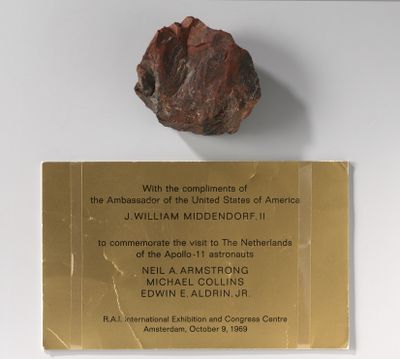Dutch doubt authenticity of ‘moon rock’
U.S. ambassador’s gift in 1969 is petrified wood, museum says

AMSTERDAM – It’s not green cheese, but it might as well be.
The Dutch national museum said Thursday that one of its prized possessions, a rock supposedly brought back from the moon by U.S. astronauts, is just a piece of petrified wood.
Rijksmuseum spokeswoman Xandra van Gelder, who oversaw the investigation that proved the piece was a fake, said the museum will keep it anyway as a curiosity.
The museum acquired the rock after the death of former Prime Minister Willem Drees in 1988. Drees received it as a private gift on Oct. 9, 1969, from then-U.S. Ambassador J. William Middendorf during a visit by the three Apollo 11 astronauts, part of a goodwill tour after the first moon landing. Middendorf, who lives in Rhode Island, told Dutch broadcaster NOS news that he had gotten it from the U.S. State Department, but couldn’t recall the exact details.
The U.S. Embassy in the Hague said it was investigating the matter.
The museum had vetted the moon rock with a phone call to NASA, Van Gelder said. She said the space agency told the museum then that it was possible the Netherlands had received a rock: NASA gave moon rocks to more than 100 countries in the early 1970s, but those were from later missions.
“Apparently no one thought to doubt it, since it came from the prime minister’s collection,” Van Gelder said.
A jagged, fist-size stone with reddish tints, it was mounted and placed above a plaque that said, “With the compliments of the Ambassador of the United States of America … to commemorate the visit to The Netherlands of the Apollo-11 astronauts.” The plaque does not specify that the rock came from the moon’s surface
The rock was on show in 2006 and a space expert informed the museum it was unlikely NASA would have given away any moon rocks three months after Apollo returned to Earth.
Researchers from Amsterdam’s Free University said they could see at a glance the rock was probably not from the moon.
“It’s a nondescript, pretty much worthless stone,” Geologist Frank Beunk concluded in an article published by the museum.